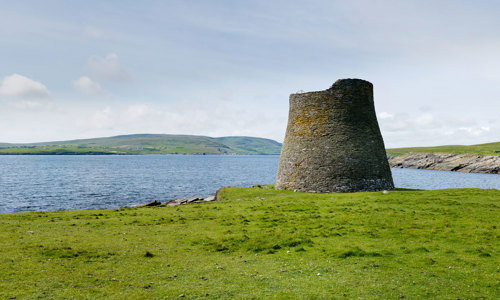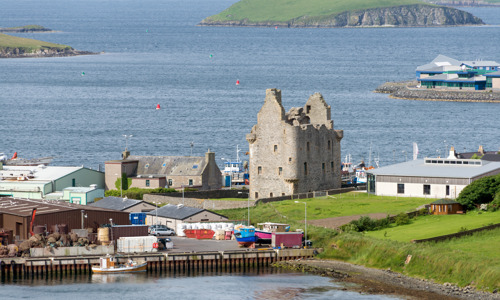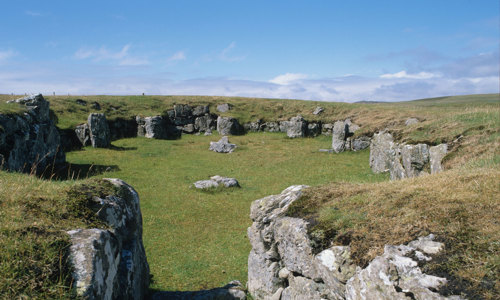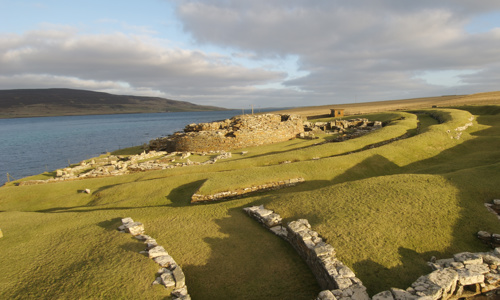History
Jarlshof lets you journey from prehistory into history. The headland above the natural harbour of West Voe was the ideal place to settle for communities spanning several millennia – from the late Neolithic era to the AD 1600s.
Layer upon layer of settlement built up on the headland. Earlier houses were abandoned and later ones built on top. Sand blown by the wind from the nearby dunes settled in between the layers and eventually sealed and protected the whole site.
Storms eventually revealed the hidden site in the 1890s. Excavations in the 1890s, 1930s and 1950s uncovered the remarkable sequence of stone structures spanning the low headland that are still visible today.
Particularly well preserved are the:
- complex of Norse longhouses and outbuildings
- Iron Age broch and wheelhouses
Remote ancestors
The first people to reach Shetland probably landed not far from Jarlshof some 5,000 to 6,000 years ago. Fragments can be seen of the earliest dwellings at Jarlshof, dating from around 2700 BC.
The remains of Bronze Age settlement, dating from at least 2000 BC, are much more substantial.
Bronze Age remains include:
- a number of houses with the living space divided up into distinctive cells, formed by buttresses or piers
- the later Bronze Age smithy, built around 800 BC, within one of the earlier houses
Iron Age village
After a relatively short period, an early Iron Age village grew up, partly built over the earlier Bronze Age settlement. These houses were also round, with cells built around a central hearth, but were more spacious inside as they didn’t have thick stone buttresses.
Two houses had souterrains (underground passages) attached, which may have been used as grain stores.
The Bronze Age and Iron Age levels:
- provide a rich variety of artefacts
- reveal evidence for trade and exchange links across Scotland and Europe
The broch
A broch was built at the site, after an apparent break in occupation. Standing now to a height of 2.4m, it would once have been a massive round stone tower, with several floors above. (Mousa Broch, 10 miles to the north, still stands 13m high.)
Other buildings soon grew up around the broch, including a:
- large, aisled roundhouse
- byre for sheltering livestock
The wheelhouses
During the first centuries AD, new structures replaced the earlier settlement. Survivals include the remains of four wheelhouses – so called because their roofs were supported on radial walls, like spokes in a wheel.
To the west of these are two huts, which were still in use around AD 800. Evidence from some of these structures, including a slate bearing a Christian cross motif, suggests they may have been occupied into the Pictish period.
Coming of the Norsemen
Vikings from Norway settled at Jarlshof in the 800s. The traditional longhouse at the heart of the farm is still clearly visible. The farmstead grew and shrank in size over some 12 to 16 generations. By the late 1200s, this settlement had been replaced by a farmhouse to the east, with barn and corn kilns attached.
A Scottish laird’s house
Shetland passed from Norway to Scotland in 1469, and in the 1500s came under the control of Earl Robert Stewart, illegitimate son of James V. Stewart’s son, Earl Patrick – or ‘Black Patie’ – built the Old House of Sumburgh, which today dominates the site. He was infamous for his tyranny over the people of Orkney and Shetland.
Sir Walter Scott named the site after the ‘Jarlshof’ or earl’s house in his novel The Pirate. Its proper name is Sumburgh, from the Old Norse ‘borg’, meaning ‘fort’.













